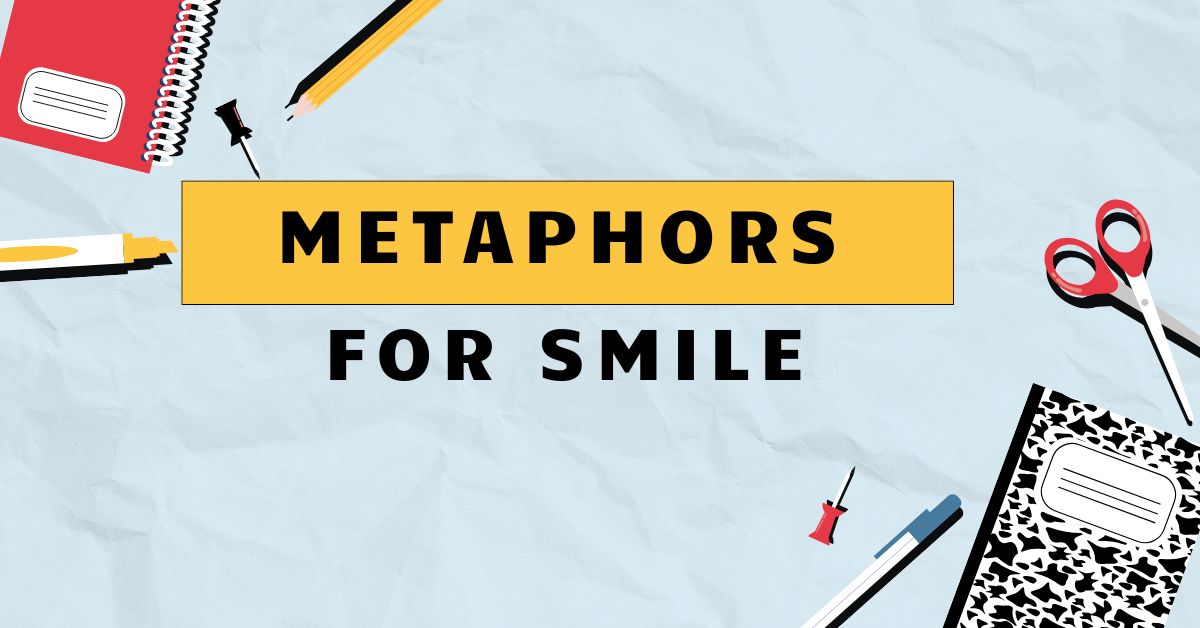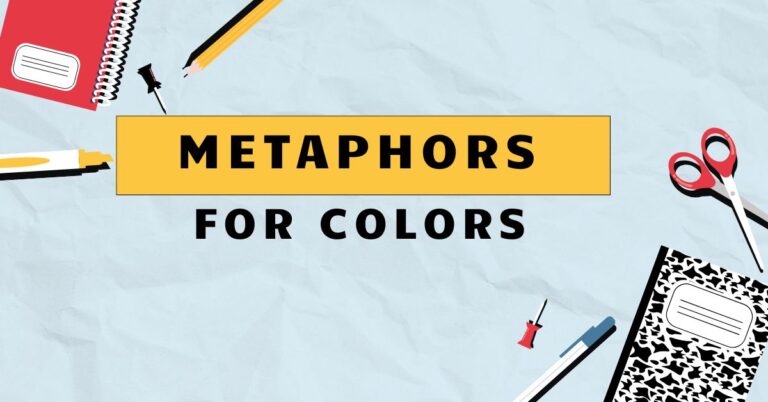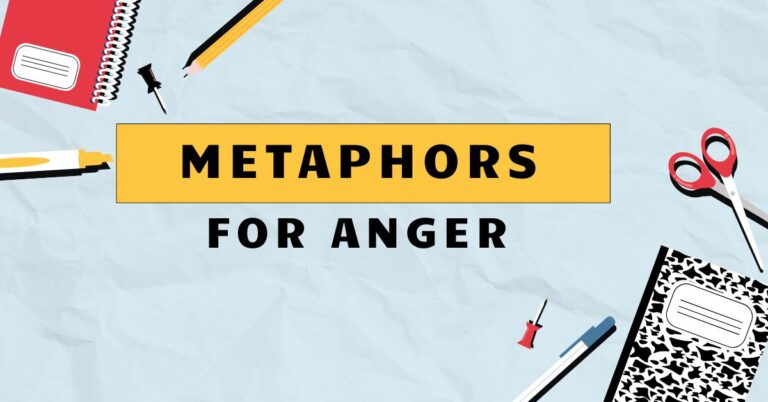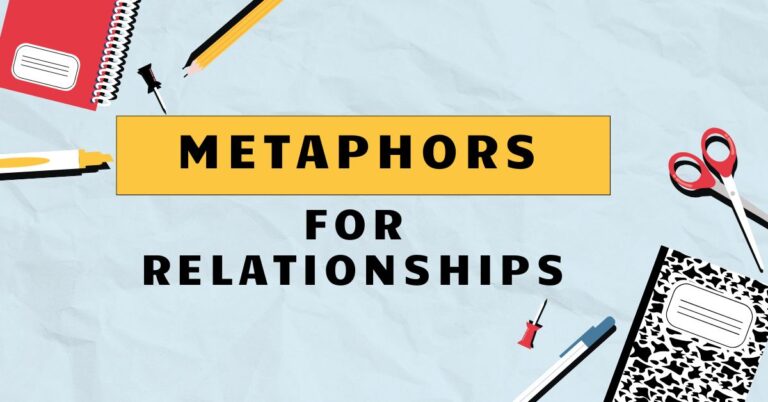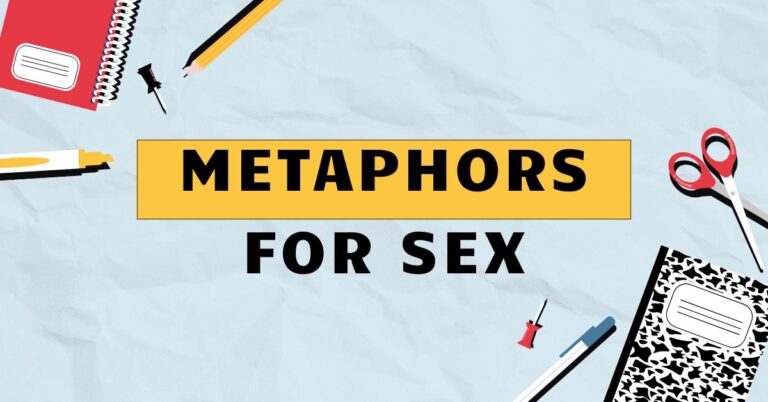31 Metaphors for Smile: A Comprehensive Guide with Examples
Understanding metaphors for ‘smile’ enhances your descriptive writing and adds depth to your communication. This article explores various metaphors used to describe a smile, explaining their meanings, contexts, and providing numerous examples.
Whether you’re a student, writer, or language enthusiast, this guide will equip you with the tools to use and interpret smile metaphors effectively, enriching your understanding of figurative language and improving your expressive abilities. By delving into the nuances of these metaphors, you can paint more vivid pictures with your words and connect with your audience on a deeper emotional level.
Table of Contents
- Introduction
- Definition of Metaphor and Smile
- Structural Breakdown of Smile Metaphors
- Types and Categories of Smile Metaphors
- Examples of Smile Metaphors
- Usage Rules for Smile Metaphors
- Common Mistakes with Smile Metaphors
- Practice Exercises
- Advanced Topics in Smile Metaphors
- FAQ
- Conclusion
Definition of Metaphor and Smile
Ametaphoris a figure of speech that directly compares two unlike things without using “like” or “as.” It asserts that one thing *is* another, implying a similarity or shared characteristic. Metaphors are used to add color, depth, and emotional resonance to language, making descriptions more vivid and engaging.
They allow writers and speakers to convey complex ideas or emotions in a concise and impactful way. Understanding metaphors is crucial for interpreting literature, poetry, and everyday communication.
Asmileis a facial expression formed by flexing the muscles near both ends of the mouth. It is a universal sign of happiness, pleasure, amusement, or friendliness.
However, smiles can also convey other emotions, such as nervousness, sarcasm, or even pain. The interpretation of a smile often depends on context, cultural background, and other non-verbal cues.
In literature and poetry, a smile is often used to symbolize joy, hope, or inner peace. It is a powerful tool for expressing emotions and connecting with others.
Structural Breakdown of Smile Metaphors
Smile metaphors typically follow a basic structure: A’s smile *is* B, where A is the person smiling and B is something else that shares a characteristic with the smile. This structure allows for creative comparisons that evoke specific images or emotions.
The effectiveness of a smile metaphor depends on the clarity of the comparison and the resonance it creates with the reader or listener. Here’s a more detailed breakdown:
- Subject (A): The person or character whose smile is being described. This is the focus of the metaphor.
- Verb (is/was): The linking verb connecting the subject and the metaphorical element.
- Metaphorical Element (B): The object, concept, or idea that the smile is being compared to. This is the core of the metaphor and carries the descriptive weight.
- Optional Modifiers: Adjectives or adverbs that further refine the description, adding more nuance and detail.
For instance, in the metaphor “Her smile was sunshine,” ‘Her smile’ is the subject, ‘was’ is the linking verb, and ‘sunshine’ is the metaphorical element. The comparison draws on the association of sunshine with warmth, brightness, and happiness, suggesting that the smile is radiant and cheerful.
Types and Categories of Smile Metaphors
Smile metaphors can be categorized based on the type of imagery they evoke. Here are some common categories:
Light-Related Metaphors
These metaphors compare a smile to different forms of light, emphasizing its brightness, warmth, and radiance. Light metaphors often convey feelings of joy, hope, and positivity.
They are particularly effective in describing genuine and heartfelt smiles.
Nature-Related Metaphors
These metaphors draw comparisons between a smile and elements of nature, such as flowers, sunshine, or landscapes. Nature metaphors can evoke feelings of peace, beauty, and tranquility.
They are often used to describe smiles that are gentle, serene, or comforting.
Object-Related Metaphors
These metaphors compare a smile to inanimate objects, highlighting their shape, texture, or function. Object metaphors can be used to describe smiles that are subtle, fleeting, or enigmatic.
They often add a unique and unexpected twist to the description.
Emotion-Related Metaphors
These metaphors directly relate a smile to other emotions, emphasizing its underlying feeling. Emotion metaphors can be used to describe smiles that are happy, sad, or even sarcastic.
They often provide a deeper insight into the character’s emotional state.
Animal-Related Metaphors
These metaphors compare a smile to the characteristics or expressions of animals. Animal metaphors can add a playful or unexpected element to the description.
They are often used to describe smiles that are mischievous, sly, or predatory.
Examples of Smile Metaphors
Here are some examples of smile metaphors, categorized by type:
Light-Related Metaphors: The following table presents examples of light-related metaphors for smiles. These metaphors often convey feelings of warmth, brightness, and joy, associating the smile with the positive qualities of light.
| Metaphor | Explanation |
|---|---|
| Her smile was sunshine on a cloudy day. | The smile brought warmth and brightness to a gloomy situation. |
| His smile was a beacon in the darkness. | The smile offered hope and guidance during a difficult time. |
| Her smile was a radiant glow. | The smile was bright and beautiful, emanating from within. |
| His smile was a flicker of candlelight. | The smile was subtle and gentle, yet still noticeable. |
| Her smile was a burst of sunlight. | The smile was sudden and intense, filling the room with joy. |
| His smile was like a warm ray of sunshine. | The smile was comforting and pleasant, like the sun’s warmth. |
| Her smile was a luminous spark. | The smile was small but significant, igniting a feeling of hope. |
| His smile was a soft glow in the twilight. | The smile was gentle and calming, like the fading light of dusk. |
| Her smile was an electric spark. | The smile was energetic and exciting, creating a palpable tension. |
| His smile was a dazzling beam. | The smile was bright and impressive, capturing everyone’s attention. |
| Her smile was a sunbeam dancing on the water. | The smile was playful and lively, full of energy and joy. |
| His smile was the light at the end of the tunnel. | The smile represented hope and a positive outcome after a difficult period. |
| Her smile was a flash of lightning. | The smile was sudden and shocking, leaving a lasting impression. |
| His smile was a warm, inviting light. | The smile was friendly and welcoming, making others feel comfortable. |
| Her smile was a shimmering ray of hope. | The smile offered a glimmer of optimism in a challenging situation. |
| His smile was as bright as a summer day. | The smile was exceptionally cheerful and filled with happiness. |
| Her smile was a guiding star in the night. | The smile provided direction and reassurance in times of uncertainty. |
| His smile was like a spotlight on her face. | The smile highlighted her beauty and drew attention to her happiness. |
| Her smile was a warm, gentle light. | The smile was comforting and kind, radiating a sense of peace. |
| His smile was a brilliant flash of insight. | The smile revealed a moment of understanding or clarity. |
| Her smile was the dawn breaking through the darkness. | The smile marked the beginning of a new and positive phase. |
| His smile was a soft, diffused light. | The smile was gentle and subtle, spreading a sense of calm. |
| Her smile was a beacon of joy. | The smile radiated happiness and optimism, inspiring others. |
| His smile was like a sunrise, full of promise. | The smile conveyed hope and the potential for a bright future. |
Nature-Related Metaphors: The following table illustrates nature-related metaphors for smiles. These metaphors often link the smile to the tranquility, beauty, and serenity found in nature, creating a sense of peace and harmony.
| Metaphor | Explanation |
|---|---|
| Her smile was a blooming flower. | The smile was beautiful and vibrant, full of life and joy. |
| His smile was a gentle breeze. | The smile was light and refreshing, bringing a sense of calm. |
| Her smile was a serene landscape. | The smile was peaceful and calming, like a beautiful vista. |
| His smile was a babbling brook. | The smile was cheerful and lively, like the sound of running water. |
| Her smile was a field of wildflowers. | The smile was colorful and diverse, full of unexpected beauty. |
| His smile was like a clear, blue sky. | The smile was open and honest, free from any hidden intentions. |
| Her smile was a tranquil lake. | The smile was calm and reflective, offering a sense of peace. |
| His smile was a whispering forest. | The smile was mysterious and intriguing, hinting at hidden depths. |
| Her smile was a mountain sunrise. | The smile was majestic and awe-inspiring, marking a new beginning. |
| His smile was a gentle rain. | The smile was soothing and refreshing, washing away worries and stress. |
| Her smile was like a blossoming cherry tree. | The smile was delicate and beautiful, a symbol of renewal and hope. |
| His smile was a quiet meadow in spring. | The smile was peaceful and inviting, full of new life and promise. |
| Her smile was a sun-drenched beach. | The smile was warm and inviting, offering a sense of relaxation and joy. |
| His smile was a soft, green valley. | The smile was comforting and nurturing, providing a sense of security. |
| Her smile was like a summer garden in full bloom. | The smile was vibrant and abundant, overflowing with happiness. |
| His smile was a serene mountain peak. | The smile was strong and resilient, offering a sense of stability. |
| Her smile was a gentle stream flowing through the woods. | The smile was natural and effortless, bringing a sense of tranquility. |
| His smile was like the first bloom of spring. | The smile was fresh and new, signaling the end of a difficult period. |
| Her smile was a peaceful forest clearing. | The smile was secluded and serene, offering a refuge from the world. |
| His smile was a quiet, starry night. | The smile was magical and enchanting, filled with wonder and awe. |
| Her smile was the rustling of leaves in the wind. | The smile was subtle and comforting, like a gentle, natural sound. |
| His smile was like a calm sea at dawn. | The smile was peaceful and promising, full of potential. |
| Her smile was a vibrant rainbow after the rain. | The smile was beautiful and hopeful, a symbol of better times to come. |
| His smile was a field of sunflowers turning towards the sun. | The smile was bright and optimistic, always seeking the positive. |
Object-Related Metaphors: The following table provides examples of object-related metaphors for smiles. These metaphors often use the characteristics of inanimate objects to describe the shape, texture, or impact of a smile, adding a unique and unexpected dimension to the description.
| Metaphor | Explanation |
|---|---|
| Her smile was a perfectly sculpted statue. | The smile was beautiful and refined, with flawless features. |
| His smile was a well-oiled machine. | The smile was smooth and effortless, appearing natural and genuine. |
| Her smile was a carefully crafted mask. | The smile was forced and artificial, hiding true emotions. |
| His smile was a loaded weapon. | The smile was dangerous and menacing, full of hidden intent. |
| Her smile was a delicate porcelain doll. | The smile was fragile and precious, easily broken or damaged. |
| His smile was like a shiny new coin. | The smile was bright and appealing, giving off a sense of freshness. |
| Her smile was a tightly wound spring. | The smile was restrained and controlled, hinting at underlying tension. |
| His smile was a rusty hinge. | The smile was stiff and awkward, lacking warmth and sincerity. |
| Her smile was a shattered mirror. | The smile was broken and fragmented, reflecting inner pain and turmoil. |
| His smile was a ticking clock. | The smile was unsettling and ominous, creating a sense of unease. |
| Her smile was like a perfectly cut diamond. | The smile was brilliant and captivating, reflecting light from all angles. |
| His smile was a smooth, polished stone. | The smile was calm and composed, radiating a sense of inner peace. |
| Her smile was a fragile glass ornament. | The smile was delicate and easily shattered, requiring careful handling. |
| His smile was a sturdy wooden bridge. | The smile was reliable and supportive, providing a connection to others. |
| Her smile was a precisely engineered machine. | The smile was calculated and deliberate, serving a specific purpose. |
| His smile was like a well-worn leather glove. | The smile was comfortable and familiar, providing a sense of security. |
| Her smile was a delicate paper flower. | The smile was beautiful but artificial, lacking genuine emotion. |
| His smile was a sharp, steel blade. | The smile was cutting and sarcastic, intended to inflict pain. |
| Her smile was a tightly sealed vault. | The smile was guarded and secretive, concealing hidden thoughts and feelings. |
| His smile was a flickering neon sign. | The smile was attention-grabbing but unreliable, lacking true warmth. |
| Her smile was the final piece of a jigsaw puzzle. | The smile completed the picture, bringing a sense of resolution and satisfaction. |
| His smile was like a perfectly tuned instrument. | The smile was harmonious and pleasing, creating a sense of balance. |
| Her smile was a carefully placed chess piece. | The smile was strategic and calculated, part of a larger plan. |
Emotional-Related Metaphors: This table showcases emotional-related metaphors for smiles. These metaphors directly compare a smile to an emotion, emphasizing the underlying feeling and providing insight into the character’s emotional state.
| Metaphor | Explanation |
|---|---|
| Her smile was pure joy. | The smile radiated happiness and delight, unadulterated and genuine. |
| His smile was silent amusement. | The smile conveyed a sense of humor and mirth, without the need for words. |
| Her smile was veiled sadness. | The smile concealed underlying sorrow and pain, masking true feelings. |
| His smile was bitter irony. | The smile conveyed sarcasm and cynicism, expressing a sense of disillusionment. |
| Her smile was quiet contentment. | The smile radiated peace and satisfaction, showing a sense of fulfillment. |
| His smile was like a surge of confidence. | The smile conveyed self-assurance and strength, inspiring others. |
| Her smile was a whisper of hope. | The smile offered a glimmer of optimism and encouragement, even in difficult times. |
| His smile was an echo of nostalgia. | The smile reflected fond memories and a longing for the past. |
| Her smile was a mask of indifference. | The smile hid true emotions, conveying a lack of interest or concern. |
| His smile was a spark of mischief. | The smile conveyed a playful and mischievous nature, hinting at playful intentions. |
| Her smile was like a wave of gratitude. | The smile expressed deep appreciation and thankfulness. |
| His smile was a sigh of relief. | The smile conveyed a sense of release and ease after a period of stress or worry. |
| Her smile was a silent apology. | The smile expressed remorse and regret, without the need for words. |
| His smile was a flicker of defiance. | The smile conveyed a rebellious spirit and a refusal to submit. |
| Her smile was a beacon of forgiveness. | The smile offered reconciliation and understanding, mending broken bonds. |
| His smile was like a current of excitement. | The smile conveyed enthusiasm and anticipation, creating a sense of energy. |
| Her smile was a hint of curiosity. | The smile expressed interest and intrigue, prompting further investigation. |
| His smile was a shadow of disappointment. | The smile revealed sadness and frustration, reflecting unfulfilled expectations. |
| Her smile was an embrace of acceptance. | The smile conveyed understanding and tolerance, welcoming others without judgment. |
| His smile was a burst of pride. | The smile radiated satisfaction and accomplishment, showing a sense of achievement. |
Animal-Related Metaphors: The following table provides examples of animal-related metaphors for smiles. These metaphors draw comparisons between a smile and the characteristics or expressions of animals, adding a playful or unexpected element to the description.
| Metaphor | Explanation |
|---|---|
| Her smile was a cat’s purr. | The smile was soft and comforting, conveying contentment and pleasure. |
| His smile was a wolf’s grin. | The smile was predatory and menacing, suggesting danger and aggression. |
| Her smile was a bird’s chirp. | The smile was cheerful and lively, expressing joy and enthusiasm. |
| His smile was a snake’s slither. | The smile was sly and deceptive, hiding true intentions and motives. |
| Her smile was a lamb’s bleat. | The smile was innocent and naive, conveying vulnerability and trust. |
| His smile was like a fox’s cunning grin. | The smile was clever and strategic, suggesting a hidden plan or scheme. |
| Her smile was a dolphin’s playful leap. | The smile was joyful and carefree, expressing lightheartedness and fun. |
| His smile was an owl’s knowing gaze. | The smile was wise and perceptive, conveying understanding and insight. |
| Her smile was a kitten’s gentle nudge. | The smile was affectionate and playful, inviting connection and warmth. |
| His smile was a bear’s protective growl. | The smile was fierce and defensive, protecting loved ones from harm. |
| Her smile was like a butterfly’s delicate flutter. | The smile was graceful and fleeting, expressing beauty and fragility. |
| His smile was a lion’s confident roar. | The smile was powerful and commanding, conveying strength and authority. |
| Her smile was a hummingbird’s quick sip. | The smile was brief and subtle, offering a fleeting moment of sweetness. |
| His smile was a hawk’s sharp gaze. | The smile was intense and focused, conveying determination and resolve. |
| Her smile was a rabbit’s nervous twitch. | The smile was anxious and uncertain, revealing underlying fear or apprehension. |
| His smile was like an eagle soaring high above. | The smile was expansive and uplifting, conveying a sense of freedom and perspective. |
| Her smile was a spider’s patient web. | The smile was calculated and strategic, designed to trap or ensnare. |
| His smile was a chameleon’s subtle shift. | The smile was adaptable and deceptive, changing to suit the situation. |
Usage Rules for Smile Metaphors
When using smile metaphors, consider the following rules:
- Clarity: Ensure the comparison is clear and understandable. The reader should be able to grasp the connection between the smile and the metaphorical element.
- Relevance: Choose metaphors that are relevant to the context and the overall tone of the writing. The metaphor should enhance the description and contribute to the overall meaning.
- Originality: Strive for originality in your metaphors. Avoid clichés and overused comparisons. A fresh and creative metaphor will be more engaging and impactful.
- Consistency: Maintain consistency in your use of metaphors. Avoid mixing metaphors or using metaphors that contradict each other.
- Appropriateness: Be mindful of the appropriateness of your metaphors. Consider the audience and the purpose of the writing. Avoid metaphors that are offensive or insensitive.
Common Mistakes with Smile Metaphors
Here are some common mistakes to avoid when using smile metaphors:
| Incorrect | Correct | Explanation |
|---|---|---|
| Her smile was like a blooming sunshine. | Her smile was sunshine. | Avoid using “like” or “as” in a metaphor; that makes it a simile. |
| His smile was a brick wall. | His smile was a cold, impenetrable wall. | Ensure the comparison is relevant and makes sense. A brick wall doesn’t inherently relate to a smile. |
| Her smile was a symphony of sunshine and gentle breezes. | Her smile was sunshine. *or* Her smile was a gentle breeze. | Avoid mixing metaphors. Stick to one clear comparison. |
Practice Exercises
Test your understanding of smile metaphors with these exercises:
Exercise 1: Identify the Metaphor
Identify the smile metaphor in each sentence:
| Question | Answer |
|---|---|
| 1. Her smile was a beacon of hope in the dark room. | a beacon of hope |
| 2. His smile was a gentle breeze on a hot day. | a gentle breeze |
| 3. Her smile was a blooming rose. | a blooming rose |
| 4. His smile was a mischievous glint in his eyes. | a mischievous glint |
| 5. Her smile was a warm ray of sunshine. | a warm ray of sunshine |
| 6. His smile was a quiet promise. | a quiet promise |
| 7. Her smile was a silent song. | a silent song |
| 8. His smile was a fragile butterfly. | a fragile butterfly |
| 9. Her smile was a hidden treasure. | a hidden treasure |
| 10. His smile was a sudden dawn. | a sudden dawn |
Exercise 2: Create Your Own Metaphors
Create a smile metaphor for each scenario:
| Scenario | Possible Answer |
|---|---|
| 1. Describing a child’s innocent smile | Her smile was pure, untainted joy. |
| 2. Describing a sarcastic smile | His smile was a razor’s edge. |
| 3. Describing a comforting smile | Her smile was a warm blanket on a cold night. |
| 4. Describing a mysterious smile | His smile was a locked door. |
| 5. Describing a radiant smile | Her smile was a supernova. |
| 6. Describing a nervous smile | His smile was a shaky bridge. |
| 7. Describing a genuine smile | Her smile was an open book. |
| 8. Describing a forced smile | His smile was a painted mask. |
| 9. Describing a gentle smile | Her smile was a soft whisper. |
| 10. Describing a captivating smile | His smile was a siren’s call. |
Advanced Topics in Smile Metaphors
For advanced learners, consider exploring these topics:
- Extended Metaphors: Develop a single smile metaphor throughout an entire paragraph or scene.
- Subverted Metaphors: Use a common smile metaphor but twist it to create an unexpected or ironic effect.
- Cultural Significance: Research how smile metaphors vary across different cultures and languages.
- Symbolism: Analyze the deeper symbolic meanings behind different types of smile metaphors.
FAQ
- What is the difference between a metaphor and a simile?
A metaphor directly compares two unlike things by stating that one *is* the other, while a simile uses “like” or “as” to make a comparison. For example, “Her smile was sunshine” (metaphor) vs. “Her smile was like sunshine” (simile).
- Why are metaphors important in writing?
Metaphors add depth, color, and emotional resonance to writing. They help create vivid images, convey complex ideas, and engage the reader’s imagination. They can make writing more memorable and impactful.
- How can I create more original smile metaphors?
To create original smile metaphors, think beyond the obvious comparisons. Consider unusual objects, concepts, or experiences that share a characteristic with a smile. Experiment with different types of imagery and play with language to create a fresh and unique effect.
- Can a smile metaphor be too abstract?
Yes, a smile metaphor can be too abstract if the comparison is unclear or difficult to understand. The reader should be able to grasp the connection between the smile and the metaphorical element. If the metaphor is too obscure, it may lose its impact and confuse the reader.
- How do I know if a smile metaphor is appropriate for my audience?
Consider the age, background, and level of understanding of your audience. Avoid metaphors that are offensive, insensitive, or too complex for them to grasp. Choose metaphors that are relevant and resonate with their experiences.
- What are some common smile metaphor clichés to avoid?
Some common smile metaphor clichés to avoid include “Her smile was like sunshine,” “His smile lit up the room,” and “Her smile was as bright as the sun.” These metaphors are overused and lack originality. Try to find fresh and creative comparisons to make your writing more engaging.
- Are there cultural differences in the interpretation of smile metaphors?
Yes, cultural differences can influence the interpretation of smile metaphors. Different cultures may associate different meanings and emotions with smiles. Be mindful of these cultural nuances when using smile metaphors, especially when writing for a diverse audience.
- How can I use smile metaphors to create a specific mood or atmosphere?
Choose smile metaphors that evoke the desired mood or atmosphere. For example, light-related metaphors can create a sense of joy and hope, while dark or unsettling metaphors can create a sense of mystery or foreboding. Consider the overall tone of your writing and select metaphors that complement it.
- Can I use multiple smile metaphors in a single piece of writing?
Yes, you can use multiple smile metaphors in a single piece of writing, but be careful not to overuse them. Too many metaphors can become overwhelming and detract from the overall impact. Use them sparingly and strategically to enhance your descriptions and create a more vivid and engaging reading experience.
- How can I practice using smile metaphors effectively?
Practice writing descriptions that incorporate smile metaphors. Experiment with different types of metaphors and pay attention to the effect they have on the reader. Read examples of well-written prose and analyze how the authors use metaphors to create vivid and memorable descriptions. Get feedback from others on your writing and use it to improve your skills.
Conclusion
Mastering the use of metaphors for ‘smile’ significantly enhances your ability to express emotions and create vivid imagery in your writing. By understanding the different types of smile metaphors – light-related, nature-related, object-related, emotion-related, and animal-related – you can add depth and nuance to your descriptions.
Remember to focus on clarity, relevance, originality, consistency, and appropriateness when crafting your metaphors. Avoid common mistakes like mixing metaphors or using clichés, and always strive to create fresh and engaging comparisons that resonate with your audience.
With practice and attention to detail, you can effectively use smile metaphors to enrich your writing and connect with readers on a deeper level.
Continue to explore the world of figurative language and experiment with different types of metaphors to expand your expressive abilities. Pay attention to how other writers use metaphors and learn from their techniques.
The more you practice, the more confident and skilled you will become in using metaphors to enhance your writing and communication. By embracing the power of metaphors, you can transform ordinary language into something extraordinary and create a lasting impact on your audience.

